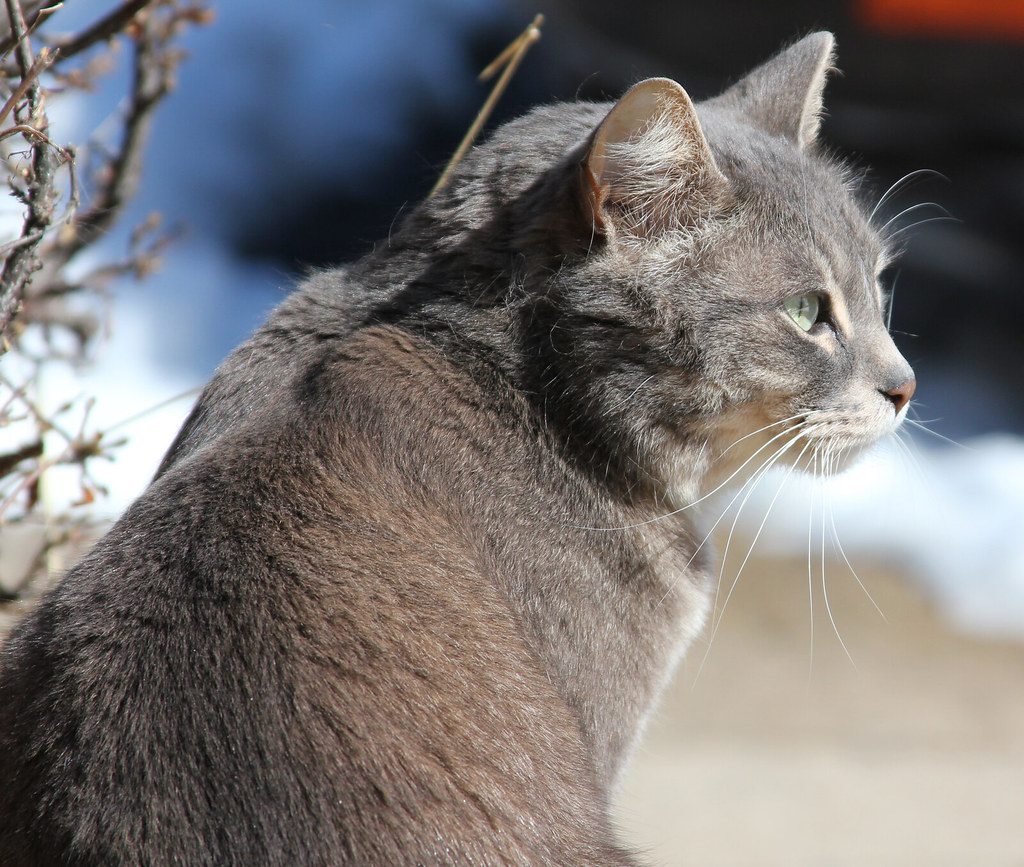Stray kittens ‘spring’ forth, put a strain on Humane Society
By Jeremy Jagodzinski
EDMONTON — Spring has sprung, which means warmer weather, blooming flowers and the birth of hundreds of kittens, fueling the city’s mounting stray cat problem.
Although strays are a year-round problem in Edmonton, the warmer weather of April means the birth of a countless number of kittens that will soon be invading a backyard or alleyway near you.
“A lot of cats tend to mate around that Valentine’s Day mark,” said Shawna Randolph, spokeswoman for the Edmonton Humane Society. “You can almost count to the day or the week. Anyways, six weeks after that is when we really start to see the numbers coming in.”

Possible stray cat without identification roaming outside in someone's front yard in Edmonton on April 5, 2012. Photograph by Jeremy Jagodzinski.
During “kitten season,” as Randolph calls it, anywhere from 50 to 70 cats are brought in by animal control or the public daily. If the humane society is lucky, 20 cats will go out. As cats keep coming in, it doesn’t take long for the EHS shelter to reach its capacity
Most of the cats found within city limits come to the EHS from Edmonton Animal Care and Control centre. Animal Control officers are on the city’s front lines walking the streets and that gives them an opportunity to not only capture stray cats, but to also observe their behaviour.
According to Animal Control, when the winter is warmer and drier, as it was this year, kittens are born in greater numbers.
“There’s a lot of other factors that also come into play,” said Stephan Exner of Animal Care and Control. “But the general trend is that cats do become a growing concern and the number increases from year to year.”
Many new cat owners remain reluctant to register their cats and have them fixed.
Last year, 5,267 cats were trapped by homeowners, taken from the streets or found in city parks and other similar areas. With 97 per cent without identification or sterilization, the majority of pets don’t make it home.
The more stray cats there are in the city, the more strain is put on the EHS’s limited resources.
“Our admitting numbers are increasing by about 1,000 every year, about two-thirds of animals at any given time are felines and about 90 per cent of felines that come through our doors are strays,” said Randolph. “We notice that there is an increase of stray felines that make it through our doors compared to previous years.”
When the EHS is dangerously close to running out of shelter space, an effort is made to reduce the number of cats in its care through Cat Adoption Initiatives.
At key times throughout the year, the public can come to the EHS shelter in the west end and adopt a spayed or neutered cat that comes equipped with a microchip, vaccinations and insurance at a reduced cost as low as 20 per cent of the regular price.
The first Cat Adoption Initiative of the season took place at the beginning of March, said Randolph. “That helps us relieve the pressure, but that’s what we’ve grown to do over the past few years at trying to manage kitten season.”
These adoption drives also provides the EHS an opportunity to discourage new cat owners from allowing their new cat to wander outdoors. Outdoor cats can be exposed to disease, which can shorten their life span.
Edmonton Animal Care and Control also discourages pet owners from letting their cats outdoors.
“Whereas a dog isn’t allowed to run at large off of the owner’s property on its own, cats are,” said Exner. “So when they’re not altered and then they’re roaming, that’s essentially how we end up with litter after litter after litter.”
The EHS also discourages purchasing cats from pet shops so as not to contribute to the further breeding of cats, especially when there are so many stray cats already still in need of a home.
However, both west-end PetSmart locations, at 170 Street as well as Stony Plain Road, do maintain a small number of stray cats on behalf of another Edmonton rescue society.
The Edmonton-based group known as the Spay Neuter Assistance Program Inc. (SNAP) also has a variety of spayed or neutered cats ready for adoption. Although SNAP has foster families to care for its cats until they’re adopted, PetSmart will sometimes house the surplus strays when there’s not enough space in the foster homes.
For those interested in adopting a cat, visit the EHS website for procedures, available services and the price for cats of different ages.











